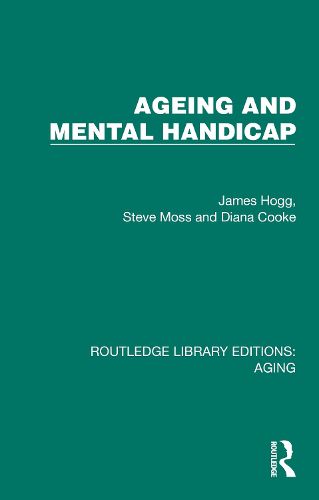Readings Newsletter
Become a Readings Member to make your shopping experience even easier.
Sign in or sign up for free!
You’re not far away from qualifying for FREE standard shipping within Australia
You’ve qualified for FREE standard shipping within Australia
The cart is loading…






In the 1980s there was growing interest in the topic of ageing and learning disabilities, for two principal reasons. First, the life expectancy of people with learning disabilities had risen significantly over the previous decades and many, once infancy had been survived, could expect a life span similar to that of non-disabled people. Secondly, a growing commitment on the part of the government and service providers to make provision for people with disabilities in the community rather than in institutions, had focused attention on this group.
Originally published in 1988, reissued here with a new foreword, this book was one of the first on this subject. It examines epidemiology and mortality, and medical and psychiatric issues compared with non-disabled older people. It considers how people with learning disabilities change in intellectual and adaptive function with age, the nature of family relationships relevant therapeutic programmes, and policy and the development of services. The book represented a major review of a hitherto neglected topic and would interest gerontologists, psychologists and professional health, social and educational staff concerned with the welfare of older people with learning disabilities.
This book is a re-issue originally published in 1988. The language used is a reflection of its era and no offence is meant by the Publishers to any reader by this re-publication.
$9.00 standard shipping within Australia
FREE standard shipping within Australia for orders over $100.00
Express & International shipping calculated at checkout
In the 1980s there was growing interest in the topic of ageing and learning disabilities, for two principal reasons. First, the life expectancy of people with learning disabilities had risen significantly over the previous decades and many, once infancy had been survived, could expect a life span similar to that of non-disabled people. Secondly, a growing commitment on the part of the government and service providers to make provision for people with disabilities in the community rather than in institutions, had focused attention on this group.
Originally published in 1988, reissued here with a new foreword, this book was one of the first on this subject. It examines epidemiology and mortality, and medical and psychiatric issues compared with non-disabled older people. It considers how people with learning disabilities change in intellectual and adaptive function with age, the nature of family relationships relevant therapeutic programmes, and policy and the development of services. The book represented a major review of a hitherto neglected topic and would interest gerontologists, psychologists and professional health, social and educational staff concerned with the welfare of older people with learning disabilities.
This book is a re-issue originally published in 1988. The language used is a reflection of its era and no offence is meant by the Publishers to any reader by this re-publication.